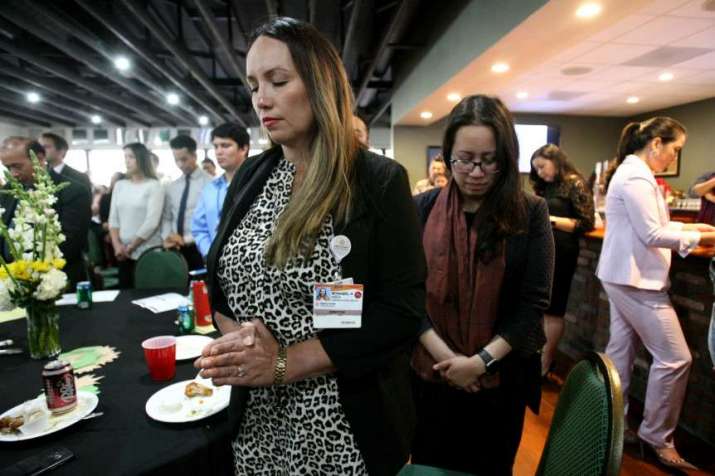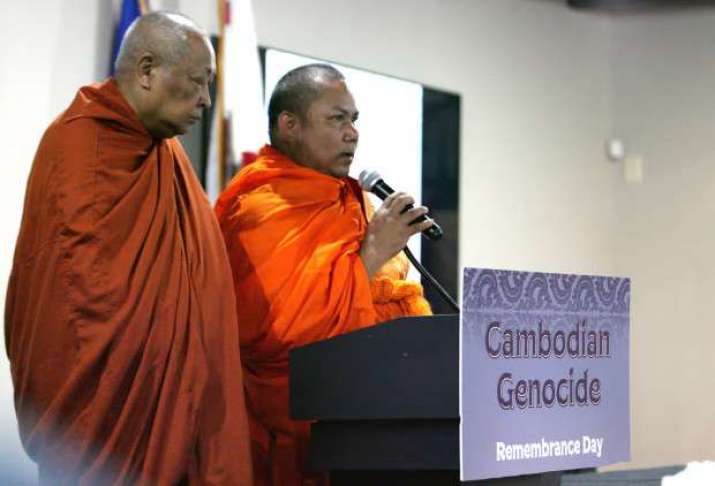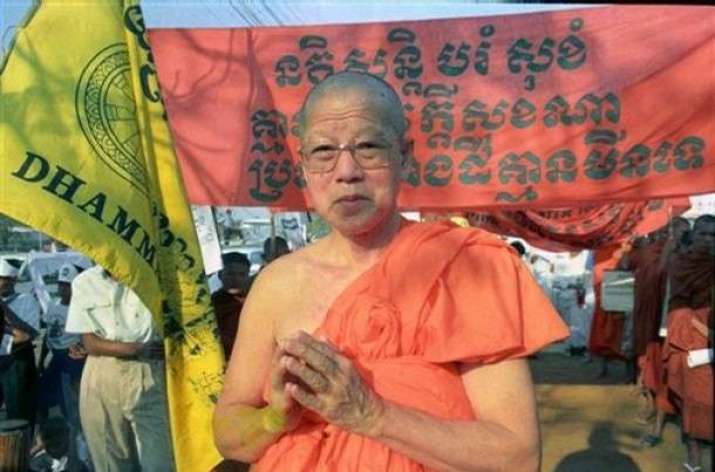NEWS
Cambodian Genocide Remembrance Day Marked in Southern California with Lotus Flower as a Symbol of Hope
 Participants join together in prayer during the Cambodian Genocide Remembrance Day at the Long Beach Fire Union Hall in Signal Hill. Image from presstelegram.com
Participants join together in prayer during the Cambodian Genocide Remembrance Day at the Long Beach Fire Union Hall in Signal Hill. Image from presstelegram.comOn Wednesday 17 April, the Cambodian community of Long Beach, Southern California marked Cambodian Genocide Remembrance Day. The event took place at the Long Beach Fire Union Hall in honor of the people who died during the Khmer Rouge regime between 1975 and 1979. Part of the observation included writing the names of loved ones on paper cut-outs of lotus flowers.
Outside of Southeast Asia, Long Beach is home to the largest population of Cambodians in the world, many of whom moved there to escape the genocide. Remembrance Day was established on 17 April, 2017 by the Los Angeles County Board of Supervisors. Shortly afterwards, the Long Beach City Council contributed $150,000 toward the building of a Killing Fields memorial in the city’s Cambodia Town.
Sayon Syrasoeuth, one of the event organizers, told Press Telegram: “[we want to] really bring the community together, and still be able to try to facilitate, and talk, and work out some components of the traumas in our community.” He explained that the lotus cut-outs will be framed into “one 8-by-8 wall of art” and is as much a therapeutic exercise for those participating in the artwork as well as a means to educate people. (Press Telegram)
 Monks speak during the Cambodian Genocide Remembrance Day at the Long Beach Fire Union Hall. Image from presstelegram.com
Monks speak during the Cambodian Genocide Remembrance Day at the Long Beach Fire Union Hall. Image from presstelegram.comIn 1975, after five years of civil war, the Khmer Rouge invaded Phnom Penh and took control of the Cambodian government. The regime was led by dictator Pol Pot who had a vision of transforming the country into a classless, agrarian society. As soon as it was in control, the Khmer Rouge started a brutal program of social engineering, forcing people out of cities and into collective farms and labor camps.
With people being executed as enemies of the regime or dying under abominable conditions, it is estimated that 1.7 to 2.2 million people died during the Khmer Rouge’s reign, roughly one-fifth of the country’s population. Although the regime targeted educated people such as doctors, teachers and artists, it also punished and killed those who could not work, such as the elderly and the disabled.
Buddhist monks were also seen as a threat to the regime. With Theravada Buddhism being the majority religion in Cambodia, Pol Pot set about cleansing the country of all things Buddhist. Monasteries and statues of the Buddha were desecrated and scriptures were burned. Monks were often forced to disrobe and to partake in activities that went counter to their faith, such as becoming farmers and marrying. More often they were killed. It is estimated that the Khmer Rouge closed 3,600 Buddhist temples during its reign and that when Vietnamese forces overthrew the regime in 1979, approximately 57,000 of Cambodia’s Buddhist priests had died, with only 3,000 remaining alive. (New York Times)
 Maha Ghosananda. Image from wagingnonviolence.org
Maha Ghosananda. Image from wagingnonviolence.orgOf the surviving monks is the notable Maha Ghosananda who was living in southern Thailand in a monastery when the Khmer Rouge came to power. Feeling disempowered over news that his entire family and a number of his friends had been killed, he followed his teacher’s advice to focus on his spiritual practice and wait until the time was right to return home. By the time 1979 arrived, Maha Ghosananda had trekked to a number of refugee camps along the Cambodian and Thai border, where he offered the refugees a piece of paper with the Buddha’s teaching: Hatred is not overcome by hatred; hatred is overcome by love. This is a law eternal. (Forest Sangha Newsletter)
Despite the Khmer Rouge’s attempt to erase Buddhism, the religion remains a source of inspiration to many Cambodians. Suely Saro of the Asian Pacific Islanders American Professional Network of Long Beach told Press Telegram that his people are “resilient”. “The lotus flower is very important in Cambodian culture,” Saro said. “it is a a symbol of revival. It blooms beautifully from the deepest and thickest mud. And, like a lotus flower, Cambodians have and will continue to rise above our deep, dark history and blossom beautifully into our future.” (Press Telegram)
See more
Cambodian Genocide Remembrance Day Honors Millions Killed (NBC Los Angeles)
Cambodians in Long Beach commemorate those who died in the country’s genocide, while seeking to move forward (Press Telegram)
The Cambodian Genocide (United to End Genocide)
Maha Ghosananda, Called Cambodia’s Gandhi, Dies (New York Times)
Cambodia's Nobel Nominee (Forest Sangha Newsletter)
Related news from Buddhistdoor Global
Monks and Activists Hold Buddhist Ceremony to Address Deforestation in Cambodia
Buddhist Monks Battle to Save Cambodia’s Forests
The Cambodian School that was Built from Garbage
Related features on Buddhistdoor Global
Buddhistdoor View: Buddhism in Southeast Asia: a Catalyst for Civic Exchange
Salvation Centre Cambodia — Fighting HIV/AIDS with the Buddha’s Army














